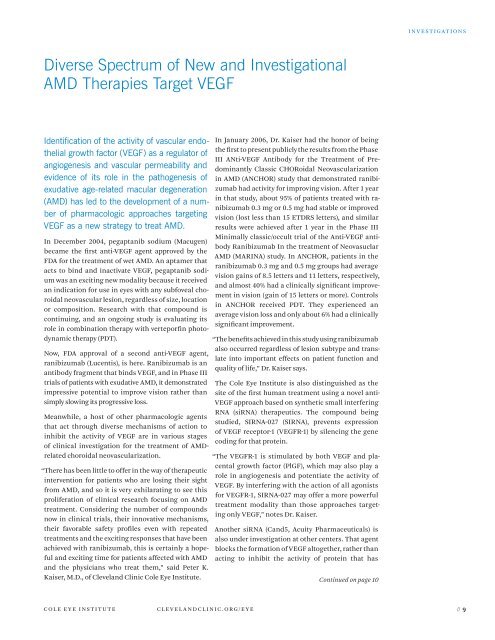Ophthalmology Update - Cleveland Clinic
Ophthalmology Update - Cleveland Clinic
Ophthalmology Update - Cleveland Clinic
Create successful ePaper yourself
Turn your PDF publications into a flip-book with our unique Google optimized e-Paper software.
Diverse Spectrum of New and Investigational<br />
AMD Therapies Target VEGF<br />
Identification of the activity of vascular endothelial<br />
growth factor (VEGF) as a regulator of<br />
angiogenesis and vascular permeability and<br />
evidence of its role in the pathogenesis of<br />
exudative age-related macular degeneration<br />
(AMD) has led to the development of a number<br />
of pharmacologic approaches targeting<br />
VEGF as a new strategy to treat AMD.<br />
in december 2004, pegaptanib sodium (macugen)<br />
became the first anti-vegF agent approved by the<br />
Fda for the treatment of wet amd. an aptamer that<br />
acts to bind and inactivate vegF, pegaptanib sodium<br />
was an exciting new modality because it received<br />
an indication for use in eyes with any subfoveal choroidal<br />
neovascular lesion, regardless of size, location<br />
or composition. research with that compound is<br />
continuing, and an ongoing study is evaluating its<br />
role in combination therapy with verteporfin photodynamic<br />
therapy (pdt).<br />
now, Fda approval of a second anti-vegF agent,<br />
ranibizumab (lucentis), is here. ranibizumab is an<br />
antibody fragment that binds vegF, and in phase iii<br />
trials of patients with exudative amd, it demonstrated<br />
impressive potential to improve vision rather than<br />
simply slowing its progressive loss.<br />
meanwhile, a host of other pharmacologic agents<br />
that act through diverse mechanisms of action to<br />
inhibit the activity of vegF are in various stages<br />
of clinical investigation for the treatment of amdrelated<br />
choroidal neovascularization.<br />
“there has been little to offer in the way of therapeutic<br />
intervention for patients who are losing their sight<br />
from amd, and so it is very exhilarating to see this<br />
proliferation of clinical research focusing on amd<br />
treatment. considering the number of compounds<br />
now in clinical trials, their innovative mechanisms,<br />
their favorable safety profiles even with repeated<br />
treatments and the exciting responses that have been<br />
achieved with ranibizumab, this is certainly a hopeful<br />
and exciting time for patients affected with amd<br />
and the physicians who treat them,” said peter K.<br />
Kaiser, m.d., of cleveland clinic cole eye institute.<br />
in January 2006, dr. Kaiser had the honor of being<br />
the first to present publicly the results from the phase<br />
iii anti-vegF antibody for the treatment of predominantly<br />
classic chOroidal neovascularization<br />
in amd (anchOr) study that demonstrated ranibizumab<br />
had activity for improving vision. after 1 year<br />
in that study, about 95% of patients treated with ranibizumab<br />
0.3 mg or 0.5 mg had stable or improved<br />
vision (lost less than 15 etdrs letters), and similar<br />
results were achieved after 1 year in the phase iii<br />
minimally classic/occult trial of the anti-vegF antibody<br />
ranibizumab in the treatment of neovasuclar<br />
amd (marina) study. in anchOr, patients in the<br />
ranibizumab 0.3 mg and 0.5 mg groups had average<br />
vision gains of 8.5 letters and 11 letters, respectively,<br />
and almost 40% had a clinically significant improvement<br />
in vision (gain of 15 letters or more). controls<br />
in anchOr received pdt. they experienced an<br />
average vision loss and only about 6% had a clinically<br />
significant improvement.<br />
“the benefits achieved in this study using ranibizumab<br />
also occurred regardless of lesion subtype and translate<br />
into important effects on patient function and<br />
quality of life,” dr. Kaiser says.<br />
the cole eye institute is also distinguished as the<br />
site of the first human treatment using a novel antivegF<br />
approach based on synthetic small interfering<br />
rna (sirna) therapeutics. the compound being<br />
studied, sirna-027 (sirna), prevents expression<br />
of vegF receptor-1 (vegFr-1) by silencing the gene<br />
coding for that protein.<br />
“the vegFr-1 is stimulated by both vegF and placental<br />
growth factor (plgF), which may also play a<br />
role in angiogenesis and potentiate the activity of<br />
vegF. By interfering with the action of all agonists<br />
for vegFr-1, sirna-027 may offer a more powerful<br />
treatment modality than those approaches targeting<br />
only vegF,” notes dr. Kaiser.<br />
another sirna (cand5, acuity pharmaceuticals) is<br />
also under investigation at other centers. that agent<br />
blocks the formation of vegF altogether, rather than<br />
acting to inhibit the activity of protein that has<br />
Continued on page 10<br />
i n v e s t i g a t i O n s<br />
c O l e e y e i n s t i t U t e c l e v e l a n d c l i n i c . O r g / e y e //
















